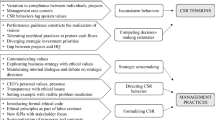Abstract
This paper examines the current state of project cultures in the German turnkey construction industry and the ideal project cultures in terms of partnering from the perspective of various key stakeholders (i.e., Investors, General Contractors, (Sub-)Contractors and Designers). To investigate the current and ideal cultures, data were gathered among the key stakeholders by means of a survey study with 72 respondents divided over 12 companies. The respondents rated the current and desired cultures by using the Organizational Culture Assessment Instrument, which belongs to the Competing Values Framework. The investigations show many similarities and differences between the stakeholder perspectives of the current and the idealized partnering project cultures. Mainly, the General Contractors desire more cooperative behaviors than the (Sub-)Contractors, and the Investors desire more pronounced flexibility than the General Contractors. All stakeholders desire a cultural change from highly competitive behaviors toward more cooperation. Changes in terms of clear procedures or more flexibility are only desired by the Designers. Defining both the current and an ideal partnering project culture enables academics and project managers to compare their actual project cultures to an ideal situation. With such an approach, academics and project managers could measure whether new tools or changes in resources affect their project cultures toward a partnering project culture.
Similar content being viewed by others
References
Akintan O A, Morledge R (2013). Improving the collaboration between main contractors and subcontractors within traditional construction procurement. Journal of Construction Engineering, 281236
Baiden B K, Agyekum K, Atuahene B T (2018). Client-contractor relations on construction projects in Ghana. International Journal of Project Organisation and Management, 10(4): 333–351
Ballard G, Howell G (1994). Implementing lean construction: Stabilizing work flow. In: 2nd Annual Conference of the International Group for Lean Construction. Santiago
Barlow J, Cohen M, Jashapara A, Simpson Y (1997). Towards Positive Partnering: Revealing the Realities in the Construction Industry. Bristol: Policy Press
Bayliss R, Cheung S O, Suen H C H, Wong S P (2004). Effective partnering tools in construction: A case study on MTRC TKE contract 604 in Hong Kong. International Journal of Project Management, 22(3): 253–263
Beach R, Webster M, Campbell K M (2005). An evaluation of partnership development in the construction industry. International Journal of Project Management, 23(8): 611–621
Black C, Akintoye A, Fitzgerald E (2000). An analysis of success factors and benefits of partnering in construction. International Journal of Project Management, 18(6): 423–434
Cameron K S, Quinn R E (2011). Diagnosing and Changing Organizational Culture—Based on the Competing Values Framework. 3rd ed. San Francisco: Jossey-Bass
Chen W T, Merrett H C, Lu S T, Mortis L (2019). Analysis of key failure factors in construction partnering—A case study of Taiwan. Sustainability, 11(14): 3994
Cheng E W L, Li H, Love P E D, Irani Z (2001). Network communication in the construction industry. Corporate Communications, 6(2): 61–70
Cheung S O, Ng T S T, Wong S P, Suen H C H (2003). Behavioral aspects in construction partnering. International Journal of Project Management, 21(5): 333–343
Cohen A R, Fink S L, Gadon H, Willits R D (1995). Effective Behavior in Organizations: Cases, Concepts, and Student Experiences. 6th ed. Burr Ridge, IL: Irwin Professional Publishing
Davis K (2014). Different stakeholder groups and their perceptions of project success. International Journal of Project Management, 32(2): 189–201
Doloi H (2013). Cost overruns and failure in project management: Understanding the roles of key stakeholders in construction projects. Journal of Construction Engineering and Management, 139(3): 267–279
Eid M, Gollwitzer M, Schmitt M (2017). Statistics and Research Methods. Weinheim, Basel: Beltz Verlag (in Germany)
Eriksson P E, Nilsson T, Atkin B (2008). Client perceptions of barriers to partnering. Engineering, Construction, and Architectural Management, 15(6): 527–539
Eschenbruch K (2008). Partnering as a management approach—definition and conceptual classification. In: Eschenbruch K, Racky P, eds. Partnering in the Construction and Real Estate Industry—Project Management and Contractual Standards in Germany. Düsseldorf, Kassel: Verlag W. Kohlhammer, 1–3 (in Germany)
Federal Ministry for Economic Affairs and Energy (2019). Economic situation and cyclical development. Available at: https://bmwi.de/Redaktion/EN/Dossier/economic-development.html
Fernandez-Solis J L, Porwal V, Lavy S, Shafaat A, Rybkowski Z K, Son K, Lagoo N (2013). Survey of motivations, benefits, and implementation challenges of Last Planner System users. Journal of Construction Engineering and Management, 139(4): 354–360
Ferreira A I (2014). Competing Values Framework and its impact on the intellectual capital dimensions: Evidence from different Portuguese organizational sectors. Knowledge Management Research and Practice, 12(1): 86–96
Field A (2018). Discovering Statistics Using IBM SPSS Statistics. London: Sage Publications
Foley J, Macmillan S (2005). Patterns of interaction in construction team meetings. CoDesign, 1(1): 19–37
Hatush Z, Skitmore M (1998). Contractor selection using multicriteria utility theory: An additive model. Building and Environment, 33(2–3): 105–115
Helfrich C D, Li Y F, Mohr D C, Meterko M, Sales A E (2007). Assessing an organizational culture instrument based on the Competing Values Framework: Exploratory and confirmatory factor analyses. Implementation Science, 2(1): 13
Hinze J, Tracey A (1994). The contractor-subcontractor relationship: The subcontractor’s view. Journal of Construction Engineering and Management, 120(2): 274–287
Hofstede G (1984). Cultural dimensions in management and planning. Asia Pacific Journal of Management, 1(2): 81–99
International Project Management Association (IPMA) (2015). Individual Competence Baseline for Project, Programme & Portfolio Management. Zurich
Johnston R, Lawrence P R (1988). Beyond vertical integration—the rise of the value-adding partnership. Harvard Business Review, 1988-07-01
Karahanna E, Evaristo J R, Srite M (2005). Levels of culture and individual behavior: An investigative perspective. Journal of Global Information Management, 13(2): 1–20
Koops L, Bosch-Rekveldt M G C, Coman L, Hertogh M, Bakker H (2016). Identifying perspectives of public project managers on project success: Comparing viewpoints of managers from five countries in North-West Europe. International Journal of Project Management, 34(5): 874–889
Koskela L (1992). Application of the new production philosophy to construction, CIFE Technical Report #72. Stanford: Center for Integrated Facility Engineering (CIFE), Stanford University
Larson E (1995). Project partnering: Results of study of 280 construction projects. Journal of Management in Engineering, 11(2): 30–35
Mossman A (2015). Last Planner—5 + 1 crucial & collaborative conversations for predictable design & construction delivery. The Change Business Ltd.
Newcombe R (2003). From client to project stakeholders: A stakeholder mapping approach. Construction Management and Economics, 21(8): 841–848
Ng S T, Rose T M, Mak M, Chen S E (2002). Problematic issues associated with project partnering—The contractor perspective. International Journal of Project Management, 20(6): 437–449
Nyström J (2005). The definition of partnering as a Wittgenstein family—resemblance concept. Construction Management and Economics, 23(5): 473–481
Ochieng E G, Price A D F (2010). Managing cross-cultural communication in multicultural construction project teams: The case of Kenya and UK. International Journal of Project Management, 28(5): 449–460
Olander S (2007). Stakeholder impact analysis in construction project management. Construction Management and Economics, 25(3): 277–287
Olawale Y A, Sun M (2010). Cost and time control of construction projects: Inhibiting factors and mitigating measures in practice. Construction Management and Economics, 28(5): 509–526
Paro P E P, Gerolamo M C (2017). Organizational culture for lean programs. Journal of Organizational Change Management, 30(4): 584–598
Pitfield L E, MacLellan A M, Kelloway E K (2015). Multicultural diversity and communication in the project context. In: Chiocchio F, Kelloway E K, Hobbs B, eds. The Psychology and Management of Project Teams: An Interdisciplinary Perspective. Oxford: Oxford University Press
Quinn R E, Spreitzer G M (1991). The psychometrics of the competing values instrument and an analysis of the impact of organizational culture on quality of life. In: Woodman R W, Pasmore W A, eds. Research in Organizational Change and Development, vol. 5. Greenwich: JAI Press, 115–142
Ranf D E (2010). Cultural differences in project management. Annales Universitatis Apulensis: Series Oeconomica, 12(2): 657–662
Sackmann S A (2009). Cultural dynamics in project work. In: Dorn K H, Engstler M, Fitzsimons C J, Kerber G, Wagenhals K, Wagner R, eds. Projects as Cultural Experience. dpunkt-Verlag, 1–16 (in Germany)
Sandrk Nukic I, Huemann M (2016). Organizational culture of the Croatian construction industry. Engineering, Construction, and Architectural Management, 23(2): 237–260
Schein E H (2017). Organizational Culture and Leadership. 5th ed. Hoboken, NJ: Jossey-Bass
Smiley J P, Fernie S, Dainty A (2014). Understanding construction reform discourses. Construction Management and Economics, 32(7–8): 804–815
Sochan M (2018). The Art of Strategic Partnering: Dancing with the Elephants. Gilroy: NAK Publishing
Sohi A J, Hertogh M, Bosch-Rekveldt M G C, Blom R (2016). Does lean & agile project management help coping with project complexity? Procedia: Social and Behavioral Sciences, 226: 252–259
Strack M (2012). Organizational culture in the Competing Values Framework: Measuring characteristics in the OCAI’s German adaption. Journal of Business and Media Psychology, 3: 30–41 (in Germany)
Turner R, Zolin R (2012). Forecasting success on large projects: Developing reliable scales to predict multiple perspectives by multiple stakeholders over multiple time frames. Project Management Journal, 43(5): 87–99
Verein Deutscher Ingenieure (VDI) (2019). VDI 2553—Lean Construction. Available at: https://vdi.de/richtlinien/details
Winch G M (1989). The construction firm and the construction project: A transaction cost approach. Construction Management and Economics, 7(4): 331–345
Winch G M (2000). Institutional reform in British construction: Partnering and private finance. Building Research and Information, 28(2): 141–155
Author information
Authors and Affiliations
Corresponding author
Rights and permissions
About this article
Cite this article
Lühr, G.J., Bosch-Rekveldt, M.G.C. & Radujkovic, M. Key stakeholders’ perspectives on the ideal partnering culture in construction projects. Front. Eng. Manag. 9, 312–325 (2022). https://doi.org/10.1007/s42524-020-0135-z
Received:
Accepted:
Published:
Issue Date:
DOI: https://doi.org/10.1007/s42524-020-0135-z




